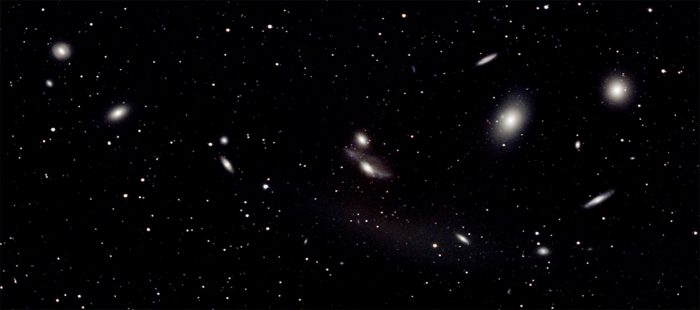
Markarian’s Chain
This is Markarian’s Chain. It’s a cluster of eight galaxies located in the constellation Virgo. (The other faint galaxies in this image are much further away and just happen to be in the line of sight of the telescope.) The two bright galaxies to the right are M86 and M84. They were both discovered by Charles Messier in 1781. The rest of the Chain was discovered by William Herschel, but I have not found any documentation stating when they were discovered.
Markarian’s Chain gets its name from Benjamin Markarian. In the 1960s, he determined that the galaxies in the cluster all share the same movement.
Markarian’s Chain is a small sample of the 1,300 galaxies that are visible, (through a telescope), in the Virgo Cluster. The Virgo Cluster is named after the constellation Virgo.
Virgo is easy to find on any clear night in April. Simply go outside at about 9:00 PM and look towards the East. The center of the Virgo Cluster is about 50 million light years away from us.
The brightest member of Markarian’s Chain is M86, with a visual magnitude of +8.8. It’s about 57 million light years away.
M84 has a visual magnitude of +9.0. It’s about 66 million light years from us.
The two bright galaxies near the center of the image are called the Eyes. They are only about 37 million light years away and both have a visual magnitude of +10. They are cataloged as NGC 4435 and NGC 4438.
The remaining four bright galaxies, (from right to left), are NGC 4461, NGC 4458, (slightly above NGC 4461), NGC 4473, and NGC 4477. NGC 4461 is 39 million light years from us and has a visual magnitude of +10.94. NGC 4458 is 53 million light years from us and has a visual magnitude of +11.99. NGC 4473 is 49 million light years from us and has a visual magnitude of +10.06. NGC 4477 is 54 million light years from us and has a visual magnitude of +10.29.
What you can look for in April’s Night Skies
April starts off with great evening views of Venus and Mars. Venus will be about 30° above the Western horizon. Mars will be about 70° above it. If you’re looking through a pair of binoculars, you might be able to spot Uranus, a little bit below Venus.
The Lyrid Meteor Shower will happen between April 16 and 25. You should be able to spot shooting stars after 10:30 p.m. on any clear night. The peak will be on the morning of the 21 at about 4:00 a.m. To see the action, go outside, lie down on your back, and simply look up at the stars!
Moon Phases:
New Moon is April 20
1st Quarter is April 27
Full Moon is April 6
Last Quarter is April 13



